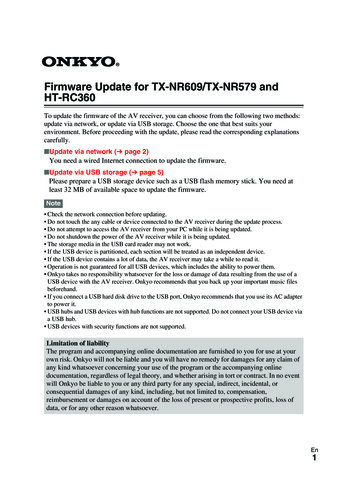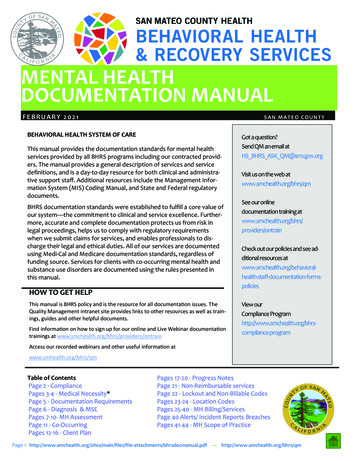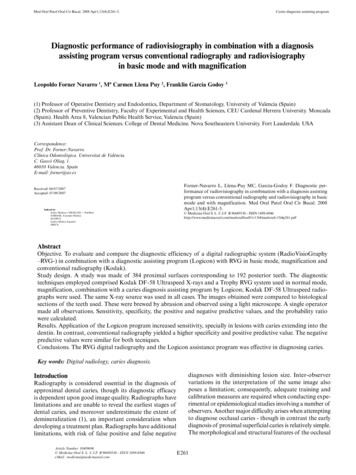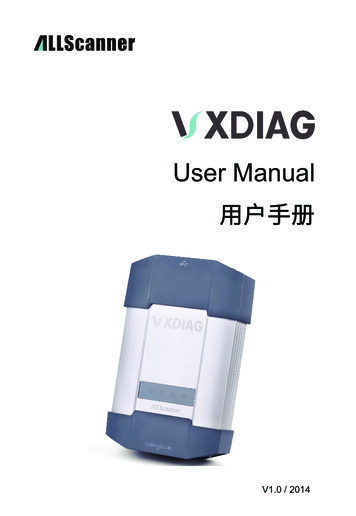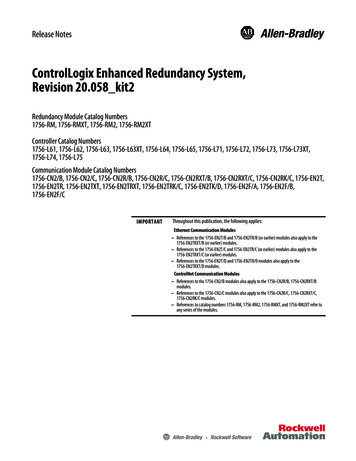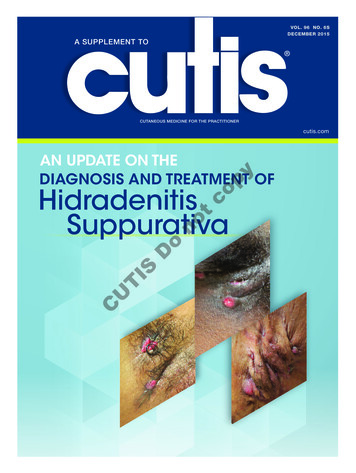
Transcription
VOL. 96 NO. 6SDECEMBER 2015A SUPPLEMENT TOCUTANEOUS MEDICINE FOR THE PRACTITIONERcutis.compyAN UPDATE ON THEDIAGNOSIS AND TREATMENT OFCUTISDonotcoHidradenitisSuppurativaCU HUMSupp 12 15 FINAL.indd 111/30/15 1:41 PM
Cutis Cutaneous Medicine for the Practitioner, December 2015,Volume 96 Number 6S.GROUP EDITORMelissa Steiger SearsTRADEMARK: Cutis is a registered trademark of Frontline MedicalCommunications Inc.MANAGING EDITOR Alicia Wendt973-206-8098PUBLISHER: Cutis (ISSN-0011-4162; E-ISSN 2326-6929)(GST #128741063) is published monthly by Frontline MedicalCommunications Inc., with business offices at 7 Century Dr, Suite 302,Parsippany, NJ 07054-4609; telephone 973-206-3434; fax 973-206-9378.ASSOCIATE EDITOR Allegra Sparta973-206-8097COPYRIGHT: Copyright Frontline Medical Communications Inc. 2015.All rights reserved. No part of this publication may be reproduced,stored in a retrieval system, or transmitted in any form or by anymeans, mechanical, computer, photocopying, electronic recording,or otherwise, without the prior written permission of Frontline MedicalCommunications Inc. The copyright law of the United States (Title 17,U.S.C., as amended) governs the making of photocopies or otherreproductions of copyrighted material.ART DIRECTOR Naina Lal973-206-8977PROOFREADERpyCREATIVE DIRECTOR Mary Ellen Niatas973-206-8973PRODUCTION MANAGER Donna Pituras973-206-8011800-480-4851SENIOR VICE PRESIDENT/GROUP PUBLISHER973-206-8952Sharon FinchtcoSUBSCRIBER INQUIRY LINEBILLING COORDINATOR Sheri Williams973-206-8022Fax 973-206-9378noPHOTOCOPY PERMISSIONS POLICY: This publication hasbeen registered with Copyright Clearance Center, Inc (CCC),222 Rosewood Dr, Danvers, MA 01923, telephone 508-750-8400.Permission is granted for the photocopying of specified articlesprovided that the base fee is paid directly to CCC (ref. Cutis ,ISSN-0011-4162, specifying volume, date, and title of article). This consent does not extend to other kinds of copying, such as for generaldistribution, resale, advertising, and promotional purposes, or forcreating new collective works.Michele V. MurrayDoOPINIONS: Opinions expressed in articles are those of the authors anddo not necessarily reflect those of Frontline Medical Communications Inc.or the Editorial Board. Frontline Medical Communications Inc. assumesno liability for any material published herein.TISREPRINTS: Contact Sharon Finch at sfinch@frontlinemedcom.com.CUPAID SUBSCRIPTIONS: All prices listed are for one-year subscription.Individual, USA, 172; Individual, Canada/Mexico, 264; Individual,all other nations, 313 surface, 403 air; Student/Resident, USA, 50;Institution, USA, 357; Institution, Canada/Mexico, 434; Institution, allother nations, 503. For single issues: USA, 29; Canada/Mexico, 36;all other nations, 41.BACK ISSUES: For back issues (subject to availability), call800-480-4851 to charge your credit card. Written requests willbe accepted and must be accompanied by a check or moneyorder. Send payment and request to Cutis , Subscription Service,151 Fairchild Ave, Suite 2, Plainview, NY 11803-1709. Claims forfree replacement of missing copies of Cutis must be made within3 months of the date of the missing issue requested. Otherwise,the cost of replacement is 36 per copy, USA; 41, Canada/Mexico; 46, all other nations.For subscriptions, please call 800-480-4851, Subscription Service,151 Fairchild Ave, Suite 2, Plainview, NY 11803-1709; ore-mail quadrantcut@emscirc.com.POSTMASTER: Send address changes to:Cutis , Subscription Service, 151 Fairchild Ave,Suite 2, Plainview, NY 11803-1709. Periodicalspostage paid at Parsippany, New Jersey, andat additional mailing offices.CLASSIFIED ADVERTISING Heather TOM PROJECTS/ Sharon FinchREPRINT INQUIRIES sfinch@frontlinemedcom.comFRONTLINE MEDICAL COMMUNICATIONS INC.Stephen Stoneburn, ChairmanDouglas E. Grose, EVP Digital Business Development/CFOAlan J. Imhoff, President/CEOJoAnn Wahl, President, Custom SolutionsDennis Quirk, Vice President, FinanceJim Chicca, Executive Director, OperationsDonna Sickles, VP, Audience DevelopmentCarol Nathan, VP, Custom ProgramsWendy Raupers, VP, Custom SolutionsJim McDonough, VP, Marketing & Customer AdvocacyPhil Soufleris, VP, SalesMark Branca, VP, Society PartnersLori Raskin, Corporate Director, Research & CommunicationsLee Schweizer, Director, eBusiness DevelopmentKaren J. Clemments, Editorial DirectorIn affiliation with Global Academy for Medical Education, LLC.Sylvia H. Reitman, MBA, VP, Medical Education & ConferencesDavid J. Small, MBA, VP, Events6 CUTIS CU HUMSupp 12 15 FINAL.indd 611/30/15 1:41 PM
An Update on the Diagnosis andTreatment of Hidradenitis SuppurativaRobert G. Micheletti, MDconglobata, and pilonidal sinus are thought to share asimilar pathophysiology and often coexist with HS.3tcopyPrevalenceThe estimated prevalence of HS ranges from lessthan 1% to 4% and varies according to the ageand demographics of the population studied, thebackground rates of diagnosis/misdiagnosis, and thespectrum of disease.2,4,5 Hidradenitis suppurativais most common in the second and third decadesof life and is rarely observed before puberty.2 Thefemale-to-male ratio is approximately 3.3:1,1 andthe population with highest incidence is womenages 20 to 29 years.5 However, severe and atypicalpresentations are more common in men.5HTISDonoHidradenitis suppurativa (HS) is a chronic, inflammatory, scarring disease that occurs most frequently along the milk lines of the body fromaxillae to groin, is most common in the secondand third decades of life, and is rarely observedbefore puber ty. It dispropor tionately affectswomen and is associated with a host of comorbidities and dramatically reduced quality of life.The delay from HS symptom onset to diagnosis isapproximately 7 years, with drastic consequencesfor patient well being. Early diagnosis and treatment are of paramount importance. While severalnonpharmacologic, pharmacologic, and surgical treatment modalities exist for HS, only oneagent, adalimumab, has been approved by the USFood and Drug Administration for this indication.Lifestyle modifications, dietary changes, patienteducation, and psychosocial support are important components of HS therapy.CUidradenitis suppurativa (HS) is a chronic,inflammatory, scarring condition of follicularocclusion involving the follicular portion ofthe pilosebaceous unit.1 Similar to acne, HS beginswith follicular occlusion and is followed by cyst formation and eventual cyst rupture, which results ininflammation of the surrounding dermis. Hidradenitissuppurativa typically manifests along the so-calledmilk lines of the body,2 including the intertriginousskin of the axillary, inframammary, inguinal, genital,and perineal areas, and is characterized by recurrent,inflamed, deep-seated acneiform nodules.1 Thesenodules gradually become abscesses associated withchronic, draining sinus tract formation, resulting inscarring, disfigurement, and life-altering disability.1As part of what is referred to as the follicular occlusion tetrad, dissecting cellulitis of the scalp, acneDr. Micheletti is Assistant Professor of Dermatology and Medicine,Perelman School of Medicine, University of Pennsylvania, Philadelphia.The author reports no conflicts of interest.PathogenesisThe pathogenesis of HS remains uncertain6; however,many factors appear to play a role. Certain behavioralrisk factors (eg, smoking, obesity, and mechanicalfriction), are modifiable.3 Although HS is not aninfectious disease, bacteria may play an importantrole by creating an occlusive biofilm or by promotingan inflammatory response.7 A role for hormone imbalance, particularly hyperandrogenism, is suspectedbut unproven.8 Some patients may have a heritableform of HS, and as many as one-third of patientshave first-degree relatives with the disease.9-11 Hostdefenses, including enhanced expression of toll-likereceptors,12 release of proinflammatory cytokines,13increased tumor necrosis factor (TNF) α expression,13activation of the interleukin (IL) 23/T helper 17pathway,14 and overproduction of IL 1β,13 have alsobeen implicated in HS pathogenesis. One hypothesisregarding the pathogenesis of HS posits a combination of environmental factors in genetically susceptible individuals.3DiagnosisThe average delay from symptom onset to HS diagnosis is approximately 7 years.3 Patients may beashamed to seek medical attention until forced toVOLUME 96, DECEMBER 2015 7CU HUMSupp 12 15 FINAL.indd 711/30/15 1:41 PM
Hidradenitis Suppurativa: Diagnosis and Treatmentdo so by severe symptoms. When patients do present, they and their providers may fail to appreciatethe disease for what it is.2 Those with HS may visitprimary care providers or the emergency departmentrepeatedly for incision and drainage of recurrent“boils.” During this time, the disease may worsenwithout proper treatment. Even mild disease, whichcan be messy, smelly, and painful, has a substantialnegative impact on quality of life (QOL). Thus,accurate and timely diagnosis of HS is critical.Without therapeutic intervention, HS typically progresses and becomes increasingly debilitating. A misseddiagnosis is a missed opportunity. The QOL impact ofHS is greater than that of chronic urticaria, psoriasis, andatopic dermatitis, among the worst conditions systematically studied in dermatology.15 Patients often experience feelings of shame, isolation, and stigmatization16and substantially diminished sexual health.17 BecauseHS is also associated with a number of comorbidities(eg, arthropathies, dyslipidemia, polycystic ovarian syndrome, psychiatric disorders, obesity, drug dependence,hypertension, diabetes, thyroid disease, alcohol dependence, and lymphoma), accurate diagnosis presents animportant opportunity to address these comorbid factors.18The diagnosis of HS must be made clinically. Biopsiesmay rule out alternate diagnoses but are otherwisenonspecific, and there are no confirmatory tests.2 Thediagnostic criteria for HS can be expressed succinctlyas characteristic lesions in characteristic locations withcyclical recurrence and chronicity.2,19 Lesions should bemultiple and bilateral over time. Typical findings areopen comedones, particularly double-headed comedones; inflammatory, tender, eroded or draining nodules;draining abscesses; fibrous scarring; and subcutaneoussinus tract formation.2 Examples of mild, moderate, andsevere presentations of HS are shown in Figures 1 to 3.Roughly 66% of patients with HS can be classified as having Hurley stage I disease, with single ormultiple abscesses but no sinus tracts or scarring.6Twenty-seven percent have Hurley stage II disease,which is characterized by single or multiple separate,recurrent abscesses with sinus tract formation andscarring. Hurley stage III disease accounts for 7% ofpatients and involves multiple interconnected tractsand abscesses effacing an entire anatomic area.6 TheSartorius score, commonly used in HS clinical trials,is a more complex scoring system that allows for moredetailed assessment.20 Such designations can be a usefulway to conceptualize disease severity and plan treatment. Accurate and early diagnosis as well as treatmentcommensurate with disease severity is essential to reducedisease burden and progression and resulting disability.Figure 1.Morphologic featuresof early hidradenitissuppurativa in theaxilla. Inflammatory,tender, eroded, anddraining papules ornodules resemblefuruncles or “boils.”The diagnosis isfrequently missedat this stage.Figure 2.Morphologic featuresof moderate hidradenitis suppurativa inthe axilla. Multipleulcerated, drainingabscesses; fibrousscarring; and sinustract formationare present, withsubcutaneouscordlike induration.CUTISDonotcopyTreatmentThere is no definitive cure for HS and no therapyuniversally effective for all patients. In most cases,Hurley stage I disease can be slowed or arrested witheffective treatment options. However, control ofHurley stage II and III disease can be elusive, andprogressive suppuration, fibrosis, scarring, and contracture may result in permanent disability. Effectivemanagement frequently requires a trial of more thanone agent or a combination of agents over time.Lifestyle and Supportive Measures—Lifestyle modifications, including smoking cessation and weightloss, can be an important part of HS therapy. Wearingloose-fitting clothing and avoiding topical irritants,such as shaving creams or antiperspirants, may diminish symptoms. Dietary modification, such as avoidingbrewer’s yeast,21 dairy products, and high glycemicdiets,1 is a frequent subject of interest among patientsbut is of unproven benefit.Supportive measures include coordination of carewith mental health services and connecting patientsto others with HS through local or national supportgroups. Patients may benefit from simple discussionand education regarding the pathophysiology ofHS and its exacerbating factors in order to reduce8 CUTIS CU HUMSupp 12 15 FINAL.indd 811/30/15 1:41 PM
CUTISDopyconofear of stigma, acknowledge and address the psychosocial burden and QOL issues, and restore somesense of control over the disease and its treatment.16Support groups, such as the Hidradenitis SuppurativaFoundation, have been formed for these reasons.While no studies specifically address the issue ofwound care in HS, counseling regarding options fornonstick wound care, absorbent dressings, and theuse of tubular net or mesh dressings instead of tapeto anchor bandages, can be useful. Physical therapyconsultation may help preserve or improve rangeof motion through stretching and exercises anddecrease uncomfortable dependent lymphedema byusing slings, wraps, and compression devices.Pharmacotherapy—Topical therapies may be ofsome utility, particularly for mild, Hurley stage Idisease. Many providers recommend daily use ofsoaps, detergents, or washes such as chlorhexidine orbenzoyl peroxide, for which some evidence of effectiveness exists.22 Some topical antibiotics may treatthe odor and pain associated with HS and decreaselesion count. The efficacy of topical clindamycin(solution or gel) was established in one study23 andreplicated in another.24 Anecdotally, dapsone gel hasbeen helpful, but its utility has not been establishedand its use may be limited by cost.25 A study usingresorcinol 15% for the treatment of flares showedthat it reduced the average duration of painfulabscesses.26 Triamcinolone acetonide is commonlyinjected into painful, flaring lesions to provide quickrelief of pain and inflammation, but no relevantclinical trial has been conducted.19Oral doxycycline and minocycline are generallywell tolerated, and prescribers are comfortable withtheir use. Anecdotally, these agents are helpfulfor mild or moderate, Hurley stage I or II disease,though in the only controlled study of this class oftFigure 3. Morphologic features of severe hidradenitissuppurativa in the axilla. Multiple inflammatory nodules,sinus tracts, and fibrous scars cover the entire axilla.drug, tetracycline failed to show superiority to topical clindamycin alone.24 Conversely, the combination of oral clindamycin with rifampin, each takentwice daily, was associated with dramatic improvement in Sartorius score in a cohort of 116 patients,56% of whom had Hurley stage II or III disease.These medications were well tolerated, with only8 stopping treatment due to adverse effects.27 Dapsonehas been used as a therapeutic agent in a few small,uncontrolled case series, with improvement reportedin 38% to 100% of patients.28,29 As with most treatments, disease tends to recur when maintenance therapy is stopped.28,29 In one small retrospective study,the combination of oral metronidazole with rifampinand moxifloxacin resulted in remission in 57% ofpatients, though dose-limiting side effects occurredin the majority of those treated.30 Other combinationoral and intravenous antibiotic regimens have shownpromise for treating HS in case series.31Retinoids such as acitretin and isotretinoin mayimprove symptoms in some patients, but their usefulness is generally limited by monitoring parameters and side effects at doses necessary to induce aresponse.32-35 Hormonal therapies aimed at modulating the contribution of androgens to disease pathogenesis may be useful in some cases.36-41 These agentsprobably work best as an add-on component of a combination regimen and are best suited for those withobesity, irregular menses, or metabolic syndrome, andfor those whose HS seems to flare with menses.Biologic agents, particularly tumor necrosisfactor α inhibitors, are an option for severe, inflammatory, Hurley stage II or III disease. Controlledtrials have demonstrated the efficacy of infliximaband adalimumab for HS, while etanercept is notrecommended based on current evidence.42,43 A double-blind, prospective study of 38 patients withmoderate-to-severe HS showed moderate (25%-50%HS Severity Index score) improvement in 60% ofthose receiving infliximab 5 mg/kg (at weeks 0, 2,6, and every 8 weeks after that) versus 6% receivingplacebo.44 A phase II randomized, placebo-controlledtrial of adalimumab in 154 patients with moderate-to-severe HS showed meaningful improvement(HS Physician Global Assessment score of clear,minimal, or mild with at least a 2-grade improvement relative to baseline) in 17.6% of those receiving adalimumab 40 mg weekly versus 9.6% of thosereceiving 40 mg every other week and 3.9% of thosereceiving placebo.45Two subsequent phase III studies of adalimumab athigher doses similar to those used for Crohn diseasehave shown more impressive results, leading to therecent approval of adalimumab by the US Food andDrug Administration as the first and only medicationVOLUME 96, DECEMBER 2015 9CU HUMSupp 12 15 FINAL.indd 911/30/15 1:41 PM
Hidradenitis Suppurativa: Diagnosis and Treatmenttcopybody study of 22 patients with Hurley stage II orIII HS, use of the 1064-nm Nd:YAG laser on individuallesions monthly for 3 months produced on average a65% decrease in severity for treated sites.53 In a secondprospective randomized controlled trial split body study,also in 22 patients, monthly Nd:YAG treatments for4 months decreased average severity by 73% fortreated sites compared to controls (23%).22In surgical deroofing, a blunt probe is used to explorethe extent of each lesion prior to surgically removingthe roof with a scalpel or loop electrocautery. A curetteis used to scrape away the floor of the exposed lesion,which is then allowed to heal by secondary intention.In an open study of 88 deroofed lesions in 44 consecutive patients with HS, no recurrence was detected in83% of lesions after a median follow-up of 34 months.54Median patient satisfaction was rated 8 on a scale of0 to 10, and 90% of patients reported they would recommend the deroofing procedure to other patients.54Surgical excision of involved areas using thecarbon dioxide laser is an additional option. In a studyof 61 patients and 185 treated areas, use of the carbondioxide laser excision and marsupialization techniquewith healing by secondary intention resulted in only2 recurrences after a follow-up of 1 to 19 years.55Radical excision with complete lesion resection andwide margins involving the entire anatomic unit maybe another effective means of achieving long-termremission. However, such surgeries may be highlymorbid, and the risk of recurrence (2.5%–33%) isrelated to the natural course of the disease and thewidth of the excision.56,57Based on the accumulated data regarding the treatment of HS, evidence-based treatment approaches toHS Hurley stages I to III are shown in the Table.CUTISDonoapproved for the treatment of moderate-to-severeHS.46 These 2 unpublished, randomized, double-blind,placebo-controlled studies (PIONEER I and PIONEERII) evaluated the safety and efficacy of adalimumabin 633 adult participants with moderate-to-severeHS (Hurley stage II or III disease). In both studies,participants received placebo or adalimumab at aninitial dose of 160 mg at week 0, 80 mg at week 2, and40 mg weekly starting at week 4 and continuingthrough week 11, with clinical response evaluated atweek 12. Hidradenitis suppurativa clinical responsewas defined as at least 50% reduction in total abscessand inflammatory nodule count with no increase inabscess or draining fistula count relative to baseline. InPIONEER I, response was 42% for high-dose adalimumab versus 26% for placebo; in PIONEER II, responsewas 59% versus 28%, respectively. No study has compared the effectiveness of infliximab and adalimumabat optimal dosing using identical response criteria.47A few small studies have reported results bothmixed and promising for other biologics in HS,with targets including the IL-23/T helper 17(ustekinumab) and IL-1β (anakinra) pathways.48-50These and similar drugs are the subject of active andongoing investigations. Other agents, such as methotrexate, cyclosporine, prednisone, and zinc, may provide temporary relief in some patients but are limitedby adverse effects and incomplete efficacy.25,51,52Surgical Therapy—A variety of laser and surgical treatment modalities are available to those withHS. The 1064-nm Nd:YAG laser, a device usedprimarily for hair removal, has been applied successfully in HS patients, supporting the hypothesis of aprimary follicular pathogenesis of the condition.53In a prospective randomized controlled trial splitTreatment Approach to HS Hurley Stages I-III Based on Available Evidenceand Expert OpinionHurley StageTreatment ApproachITopical clindamycin benzoyl peroxide wash /– systemic Abx (usually doxycycline) /– Nd:YAG laserIITopical clindamycin benzoyl peroxide wash systemic Abx (clindamycin rifampin) orbiologic therapy (infliximab, adalimumab) /– Nd:YAG laser, deroofing, or CO2 laser;consider adjunctive hormonal therapies in appropriate patientsIIITopical clindamycin benzoyl peroxide wash systemic Abx (clindamycin rifampin) orbiologic therapy (infliximab, adalimumab) /– deroofing, CO2 laser, or radical excisionconsider other antibiotic combinations, other biologic therapies (anakinra, ustekinumab)consider adjunctive hormonal therapies in appropriate patientsAbbreviations: Abx, antibiotics; CO2, carbon dioxide; Nd:YAG, neodymium-doped yttrium aluminum garnet.10 CUTIS CU HUMSupp 12 15 FINAL.indd 1011/30/15 1:41 PM
Hidradenitis Suppurativa: Diagnosis and Treatmenttcopy11. Gao M, Wang PG, Cui Y, et al. Inversa acne (hidradenitissuppurativa): a case report and identification of the locusat chromosome 1p21.1-1q25.3. J Invest Dermatol.2006;126:1302-1306.12. Hunger RE, Surovy AM, Hassan AS, et al. Toll-likereceptor 2 is highly expressed in lesions of acne inversaand colocalizes with C-type lectin receptor. Br J Dermatol.2008;158:691-697.13. van der Zee HH, de Ruiter L, van den Broecke DG, et al.Elevated levels of tumour necrosis factor(TNF)-α, interleukin (IL)-1β and IL-10 in hidradenitis suppurativa skin: a rationale for targeting TNF-α and IL-1β. Br J Dermatol. 2011;164:1292-1298.14. Schlapbach C, Hänni T, Yawalkar N, et al. Expression of theIL-23/Th17 pathway in lesions of hidradenitis suppurativa.J Am Acad Dermatol. 2011;65:790-798.15. Wolkenstein P, Loundou A, Barrau K, et al. Quality oflife impairment in hidradenitis suppurativa: a study of61 cases. J Am Acad Dermatol. 2007;56:621-623.16. Esmann S, Jemec GB. Psychosocial impact of hidradenitis suppurativa: a qualitative study. Acta Derm Venereol.2011;91:328-332.17. Kurek A, Peters EM, Chanwangpong A, et al. Profounddisturbances of sexual health in patients with acneinversa. J Am Acad Dermatol. 2012;67:422-428.18. Shlyankevich J, Chen AJ, Kim GE, et al. Hidradenitissuppurativa is a systemic disease with substantial comorbidity burden: a chart-verified case-control analysis. J AmAcad Dermatol. 2014;71:1144-1150.19. Jemec GB. Clinical practice. Hidradenitis suppurativa.N Engl J Med. 2012;366:158-164.20. Sartorius K, Emtestam L, Jemec GB, et al. Objectivescoring of hidradenitis suppurativa reflecting the roleof tobacco smoking and obesity. Br J Dermatol.2009;161:831-839.21. Cannistrà C, Finocchi V, Trivisonno A, et al. Newperspectives in the treatment of hidradenitis suppurativa: surgery and brewer’s yeast-exclusion diet. Surgery.2013;154:1126-1130.22. Mahmoud BH, Tierney E, Hexsel CL, et al. Prospective controlled clinical and histopathologic study ofhidradenitis suppurativa treated with the long-pulsedneodymium:yttrium-aluminium-garnet laser. J Am AcadDermatol. 2010;62:637-645.23. Clemmensen OJ. Topical treatment of hidradenitissuppurativa with clindamycin. Int J Dermatol. 1983;22:325-328.24. Jemec GB, Wendelboe P. Topical clindamycinversus systemic tetracycline in the treatment ofhidradenitis suppurativa. J Am Acad Dermatol.1998;39:971-974.25. Scheinfeld N. Hidradenitis suppurativa: A practicalreview of possible medical treatments based on over350 hidradenitis patients. Dermatol Online J. 2013;19:1.noConclusionHidradenitis suppurativa is a chronic, relapsingdisorder of the pilosebaceous unit that leads torecurrent inflammation and scarring of the dermisand subcutaneous tissue. The pathogenesis of HS,which is complex and poorly understood, appears tobe a combination of environmental factors in genetically susceptible individuals. Some behavioral riskfactors, such as smoking and obesity, are modifiable,while the role of bacteria and the host inflammatoryresponse may be modulated by pharmacologic andsurgical therapies.Even in its milder forms, HS can negativelyimpact QOL in a substantial way. The disease isfrequently painful, messy, and stigmatizing, problems made worse by long periods of diagnostic delay.Because of the serious and chronic nature of HS,its sequelae, and comorbidities, a thoughtful andmultimodal approach to treatment, including medical and surgical modalities but also patient education, lifestyle modification, pain control, andemotional support, is necessary. The recent US Foodand Drug Administration approval of adalimumaboffers a promising new option and dosing regimenfor patients with severe disease.oREFERENCESCUTISD1. Margesson LJ, Danby FW. Hidradenitis suppurativa.Best Pract Res Clin Obstet Gynaecol. 2014;28:1013-1027.2. Alikhan A, Lynch PJ, Eisen DB. Hidradenitis suppurativa: acomprehensive review. J Am Acad Dermatol. 2009;60:539-561.3. van der Zee HH, Laman JD, Boer J, et al. Hidradenitis suppurativa: viewpoint on clinical phenotyping, pathogenesis andnovel treatments. Exp Dermatol. 2012;21:735-739.4. Jemec GB, Heidenheim M, Nielsen NH. The prevalence ofhidradenitis suppurativa and its potential precursor lesions. JAm Acad Dermatol. 1996;35:191-194.5. Vazquez BG, Alikhan A, Weaver AL, et al. Incidenceof hidradenitis suppurativa and associated factors: apopulation-based study of Olmsted County, Minnesota.J Invest Dermatol. 2013;133:97-103.6. Canoui-Poitrine F, Le Thuaut A, Revuz JE, et al. Identification of three hidradenitis suppurativa phenotypes: latent classanalysis of a cross-sectional study. J Invest Dermatol.2013;133:1506-1511.7. Kathju S, Lasko LA, Stoodley P. Considering hidradenitissuppurativa as a bacterial biofilm disease. FEMS ImmunolMed Microbiol. 2012;65:385-389.8. Barth JH, Layton AM, Cunliffe WJ. Endocrine factors in preand postmenopausal women with hidradenitis suppurativa.Br J Dermatol. 1996;134:1057-1059.9. Wang B, Yang W, Wen W, et al. Gamma-secretase gene mutations in familial acne inversa. Science. 2010;330:1065.10. Fitzsimmons JS, Guilbert PR. A family study of hidradenitis suppurativa. J Med Genet. 1985;22:367-373.VOLUME 96, DECEMBER 2015 11CU HUMSupp 12 15 FINAL.indd 1111/30/15 1:41 PM
Hidradenitis Suppurativa: Diagnosis and Treatmenttcopy42. Lee RA, Dommasch E, Treat J, et al. A prospective clinicaltrial of open-label etanercept for the treatment of hidradenitissuppurativa. J Am Acad Dermatol. 2009;60:565-573.43. Adams DR, Yankura JA, Fogelberg AC, et al. Treatmentof hidradenitis suppurativa with etanercept injection. ArchDermatol. 2010;146:501-504.44. Grant A, Gonzalez T, Montgomery MO, et al.Infliximab therapy for patients with moderate to severehidradenitis suppurativa: a randomized, double-blind,placebo-controlled crossover trial. J Am Acad Dermatol.2010;62:205-217.45. Kimball AB, Kerdel F, Adams D, et al. Adalimumab for thetreatment of moderate to severe Hidradenitis suppurativa: aparallel randomized trial. Ann Intern Med. 2012;157:846-855.46. AbbVie’s Humira (adalimumab) Receives First and OnlyU.S. Food and Drug Administration Approval for Moderate toSevere Hidradenitis Suppurativa. North Chicago, IL: AbbVie;September 10, 2015.47. van Rappard DC, Leenarts MF, Meijerink-van ‘t Oost L,et al. Comparing treatment outcome of infliximab and adalimumab in patients with severe hidradenitis suppurativa.J Dermatolog Treat. 2012;23:284–289.48. Gulliver WP, Jemec GB, Baker KA. Experiencewith ustekinumab for the treatment of moderate to severehidradenitis suppurativa. J Eur Acad Dermatol Venereol.2012;26:911-914.49. Leslie KS, Tripathi SV, Nguyen TV, et al. Anopen-label study of anakinra for the treatment of moderate to severe hidradenitis suppurativa. J Am AcadDermatol. 2014;70:243-251.50. van der Zee HH, Prens EP. Failure of anti-interleukin-1 therapyin severe hidradenitis suppurativa: a case report. Dermatology.2013;226:97-100.51. Brocard A, Knol AC, Khammari A, et al. Hidradenitis suppurativa and zinc: a new therapeutic approach. a pilot study.Dermatology. 2007;214:325-327.52. Jemec GB. Methotrexate is of limited value in the treatment ofhidradenitis suppurativa. Clin Exp Dermatol. 2002;27:528-529.53. Tierney E, Mahmoud BH, Hexsel C, et al. Randomized control trial for the treatment of hidradenitis suppurativa with aneodymium-doped yttrium aluminium garnet laser. DermatolSurg. 2009;35:1188-1198.54. van der Zee HH, Prens EP, Boer J. Deroofing: atissue-saving surgical technique for the treatment of mildto moderate hidradenitis suppurativa lesions. J Am AcadDermatol. 2010;63:475-480.55. Hazen PG, Haze
222 Rosewood Dr, Danvers, MA 01923, telephone 508-750-8400. Permission is granted for the photocopying of specified articles provided that the base fee is paid directly to CCC (ref. , Cutis ISSN-0011-4162, specifying volume, date, and title of article). This con- sent does

